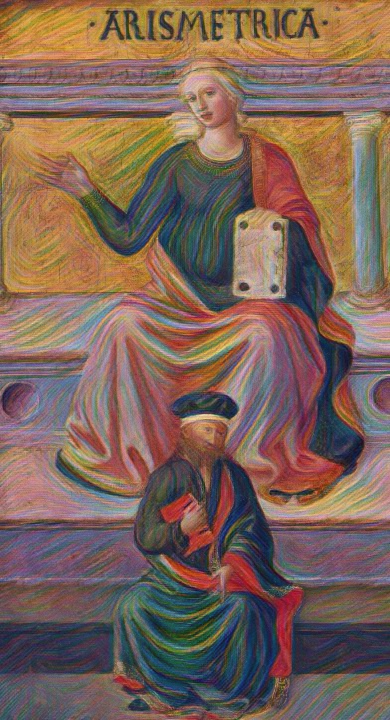Arithmetic

Arithmetic is the science of pure extension determinable by numbers; it is the science of numbers.
Writers on secular science assign it, under the head of mathematics, to the first place, because it does not presuppose any of the other sciences. Music, geometry, and astronomy, on the contrary, need the support of arithmetic for a full understanding; without it they cannot arise or exist. We should know, however, that the learned Hebrew Josephus, in his work on Antiquities (Chapter VIII of Book I) makes the statement that Abraham brought arithmetic and astronomy to the Egyptians; but that they as a people of penetrating mind, extensively developed from these seeds, the other sciences. The holy Fathers were right in advising those eager for knowledge to cultivate arithmetic, because in large measure it turns the mind from fleshly desires and furthermore awakens the wish to comprehend what with God’s help we can merely receive with the heart. Therefore the significance of number is not to be underestimated. Its very great value for an interpretation of many passages of Holy Scripture is manifest to all who exhibit zeal in their investigations.
Not without good reason is it said in praise of God, “Thou hast ordained all things by measure, number, and weight” (Book of Wisdom XI, 21). But every number, through its peculiar qualities, is so definite that none of the others can be like it. They are all unequal and different. The single numbers are different; the single numbers are limited; but all are infinite. Those with whom Plato stands in especial honor will not make bold to esteem numbers lightly, as if they were of no consequence for the knowledge of God. He teaches that God made the world out of numbers. And among us the prophet says of God, “He forms the world by number.” And in the Gospel the Savior says, “The very hairs of your head are all numbered.” Ignorance of numbers leaves many things unintelligible that are expressed in the Holy Scripture in a derivative sense or with a mystical meaning.
Practical (Applied) Mathematics
Mathematics is perhaps the most fundamental of sciences without which understanding we simply fail to progress in the fields of; Logic, Astronomy, (Technical) Music and Geometry. Mathematics can thereby be said to underpin the majority of the Seven Liberal Arts and Sciences. Without mathematics there is simply no Geometry and without Geometry, Masonry would not be the exact science it purports to be.
Quantity surveyors have measured length and width and calculate perimeter, area and volume to ascertain quantities required for a construction project. Architects used a number of mathematical disciplines including geometry, algebra and trigonometry to plan blueprints and initial sketches. Designers used geometry to create aesthetically pleasing spaces.
Employers have had to rely on mathematics to calculate wages, produce quotations, invoices and estimates where an ‘inexact’ calculation may deliberately be performed based on an average (mean, median or mode). In which case, data has to be accumulated which needed sorting or tabulation. Data which may then be presented in more palatable, visual form using pictograms such as bar or pie charts or line graphs.
Ensuring right angles (90 degrees) was essential when setting out the initial foundations of the intended structure. This was most easily achieved using the 3:4:5 triangle method. A triangle, which has sides of length 3 metres, 4 metres and 5 metres, will always have a right angle between the 3-metre side and the 4-metre side. The same is true for a triangle constructed in cubits, cm, feet, yards, chains or furlongs, so scale is unimportant but relative proportion essential.
Fractions and percentages have to be added, subtracted and multiplied, graphs had be used to extrapolate information and forecast trends, the circumference of columns was calculated from their diameter. The rise and tread of each step in stairs was calculated by simple division and the pitch determined by geometry.
Once triangle theory is understood, a straight length of many miles may accurately be measured and the area of an irregular field or plot may more readily be ascertained.
Once trigonometry and geometry are understood, then the height of a Catenarian Arch (the curve of a hanging rope or chain) may be calculated as either: y = (a/2)(ex/a + e-x/a) or as y = cosh(x/a)
![]()
